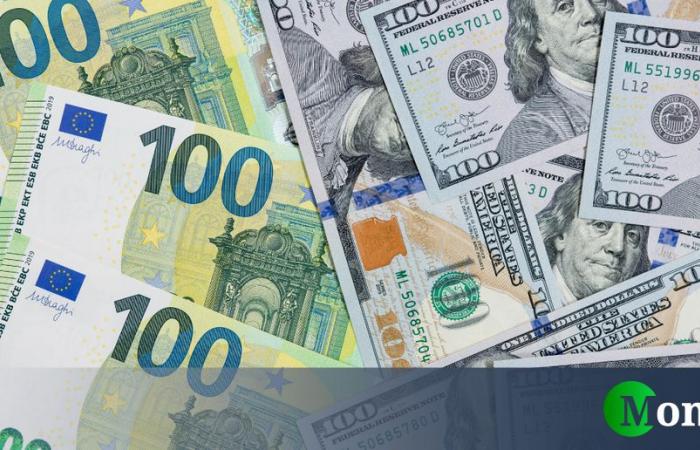L’Euro dollar fluctuates around the 1.0700 threshold, with the greenback which maintained the ground gained in the previous days. L’EUR/USD settled below 1.0700 for the second consecutive week during Asian trading on June 28.
The couple remains under pressure for a number of reasons. Expectations on Fed cutsthe publication of US and Eurozone macro data, the gap between the US central bank and the others, primarily the ECB and the BoJ, the geopolitical uncertainties and the outcome of the Trump-Biden debate are impacting the currency market and the dollar in particular. The greenback seems to persist in its run, weakening other currencies, including the euro.
Compared to the weekly peak of 1.074 euros per dollar, the EUR/USD pair lost 0.35% according to the opening exchange rate of European markets. Compared to the peak at the beginning of the month at 1.0908 (June 4), the euro-dollar has shown a decline of about 2%.
Traders who follow the currency market and the forecasts on the euro dollar they monitor 3 key factorswhich may impact the couple in the coming weeks.
1. Fed and rate cuts
The dollar index reached an eight-week high on Wednesday, June 26 at 106.13 and has so far recorded an increase of 1.5% in the quarter. At the time of writing it travels above 105.
This is the second consecutive quarterly gain, driven mainly by the reduction in expectations on rate cuts in the United States in the last six months. The The Federal Reserve’s preferred measure of inflationthe personal consumption expenditures (PCE) index, will be released at 2:30 p.m. ET and will offer important clues about the path of U.S. money. If its annual growth slows to 2.6% in May, as economists expect, it could pave the way for cuts later this year.
It should be noted that part of the US dollar’s recent rise came in response to aggressive comments from Fed officials, while its growing monetary policy gap with other major central banks has also contributed to the decline of the euro.
On Wednesday, FOMC Chair Michelle Bowman reiterated her primary view that inflation will decline with rates held steady. Rate cuts can only come if inflation stabilizes around 2%. Her colleague Raphael Bostic, president of the Atlanta Fed, argued that U.S. inflation “appears to be coming down,” potentially paving the way for lower interest rates later this year.
The CME Group’s FedWatch tool maintains a roughly 65% chance of lower interest rates in September versus a nearly 93% chance for the Dec. 18 meeting.
2. ECB and Eurozone economy
The strength or weakness of the community currency against the dollar also depends on the economic performance of the Eurozone and on the moves of ECB monetary policy.
The Eurotower’s recent rate cut of 25 basis points, compared to the Fed’s decision to keep the cost of money steady, has widened the policy gap between the two central banks. This could lead to further weakness in EUR/USD according to the shared analysis of the experts.
Market expectations suggest two more rate cuts by the ECB during the year.
In this regard, Peter Kazimir, member of the Governing Council of the central bank, said that there could be another rate cut by the end of the year, but not in the summer. After having taken the move to reduce the cost of money in June, the ECB could opt for a more cautious stance in the next meetings. Falling inflation is not immune to external shocks and the 2% target has not yet been reached.
A further rate cut should be decided between September and December. A more aggressive ECB than the Fed should translate into a decline in the euro dollarwhereas higher rates push up bond yields and currencies.
3. Political factors. US and French elections in focus
Il Trump-Biden debate which aired on the night of Thursday 27 June strengthened the dollar, discounting a victory for the Republican candidate, who appeared more lively than an insecure Biden.
As highlighted by ING strategists, “we believe that a potential Trump administration is more positive for the dollareither through a more accommodative fiscal policy or through a more aggressive trade/tariff environment.”
Similar opinion also from other observers. “Markets probably extrapolated the outcome of today’s debate to the actual outcome of the November elections”said Carol Kong, strategist at the Commonwealth Bank of Australia in Sydney. “Trump’s policies are likely to increase inflationary pressures and exacerbate trade tensions, thereby supporting US interest rates and the US dollar as a safe haven currency”.
On the European front, the political spotlight is all on the French elections, considered a factor of financial turbulence. According to an analysis by ING strategists:
“The question for the market is whether the Le Pen government will look at the French bond market and start to abandon some of its plans to apparently unfunded tax cuts – or it will move on.
Our Eurozone team suspects that it will be too soon for a new government to substantially water down its pre-election pledges and that they could be difficult months until Septemberwhen France will have to deliver to Brussels its plans on how to resolve the situation.”
In this scenario of more “populist” economic policies, the euro is seen falling.






